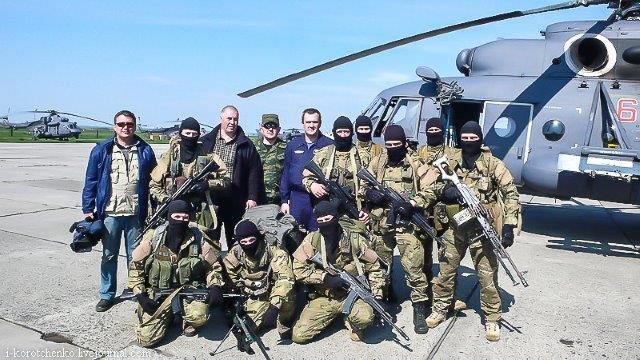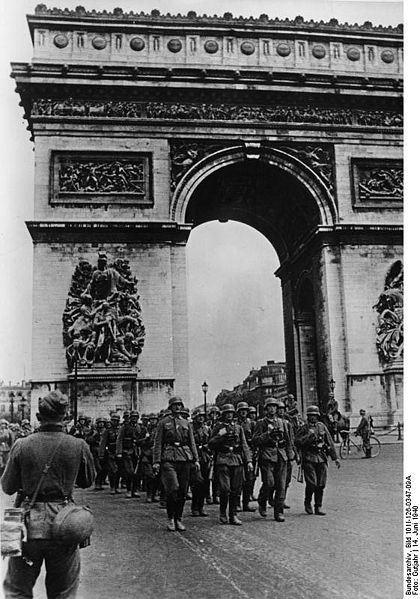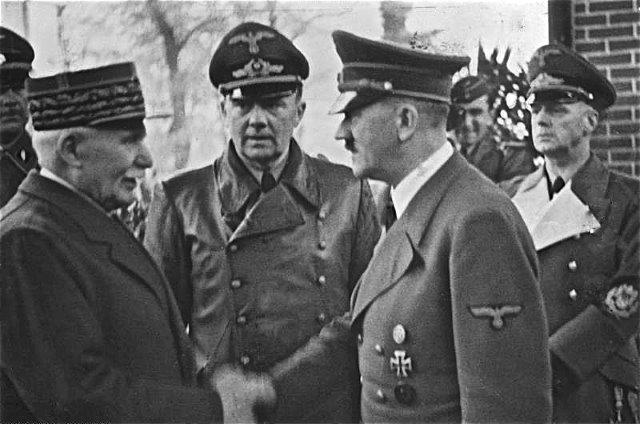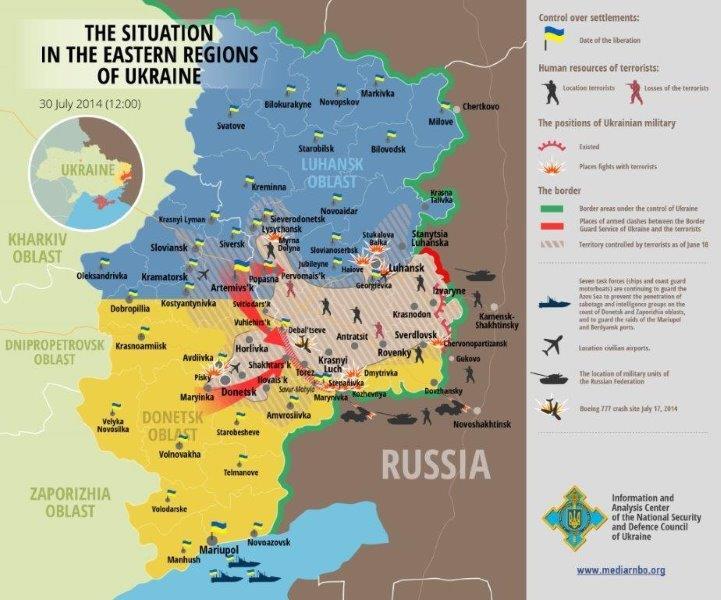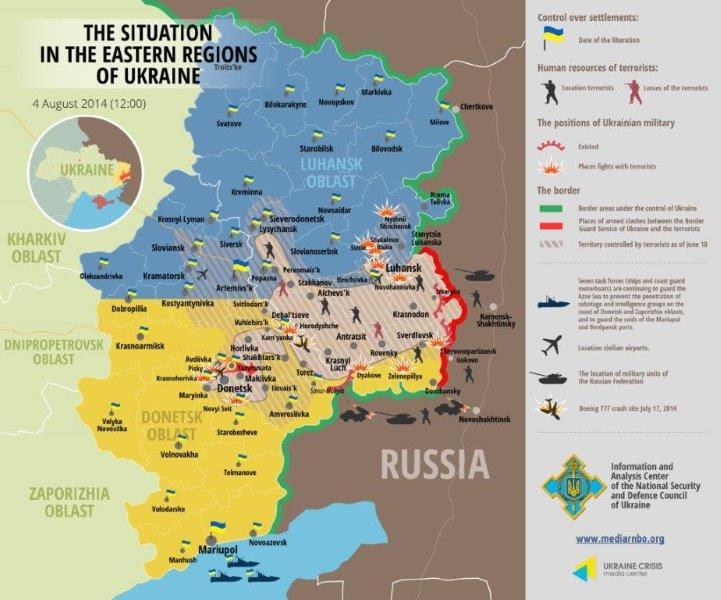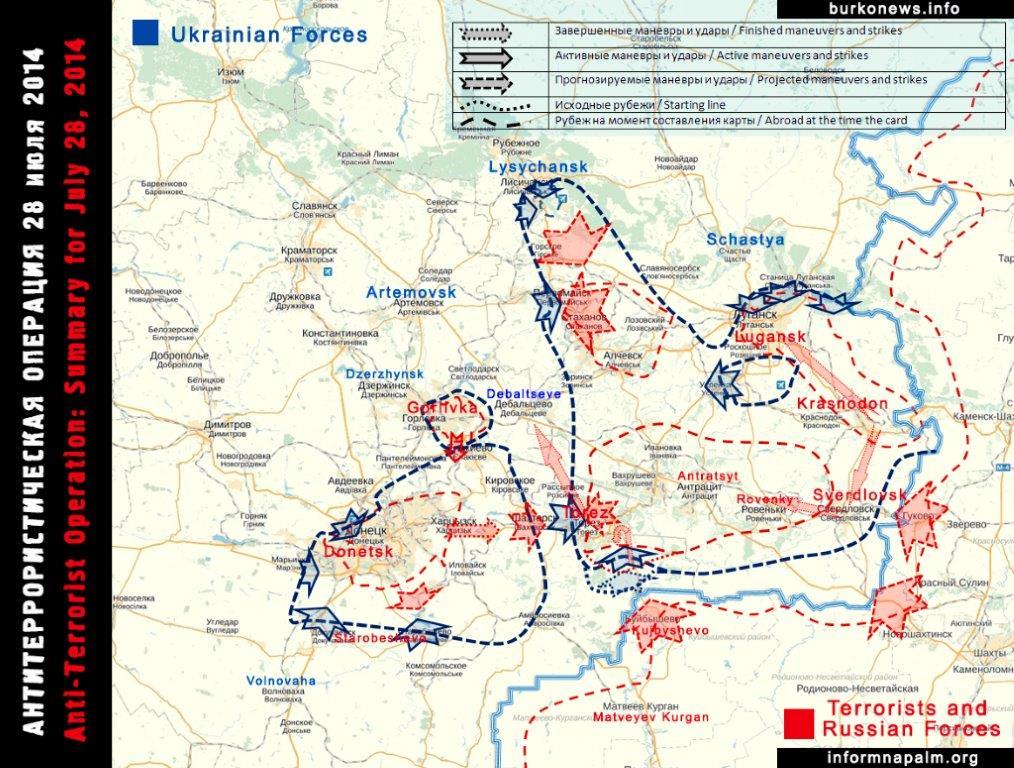by Vitalii Usenko and Dmytro Usenko
New tools and methods of warfare, totally unexpected by Russia and terrorists, are being put into practice by the Ukrainian army.
The Ukrainian Armed Forces have started to fight the battle for the southeast according to all laws of modern military science.
Successes of the Ukrainian army have caused huge irritation and desperation in Russia. Russia has deployed strike groups near the Ukrainian border to demonstrate its invasion readiness. Following such developments, substantial military aid from US, EU and Nato is needed.
Thanks to the endurance and heroism of the Ukrainian troops, illegal armed formations of terrorists (IAF) were not able to destroy encircled Ukrainian forces caught in the Izvaryne pocket in the way that was originally planned. Considerable numbers of terrorists were pinned down on the perimeter. This allowed the Ukrainian Armed Forces to take countermeasures and fully seize the strategic initiative.
Some Ukrainian and foreign media are distributing information that the General Staff of Ukraine is doing nothing to help the units, caught in the Izvaryne pocket. Such publications are a example of the unjustified panic and the incompetence of “couch” military experts quoted by the media. It is happening because of the lack of understanding by the media of the elementary principles of modern military strategy.
Many publications have discussed the “lost strategic initiative” by the anti-terrorist operation (ATO) forces and the reinvigoration of the terrorists’ illegal armed formations (IAF) during the breakout of the Girkin terrorist group from Sloviansk to Donetsk. The issue was that armed forces of Ukraine conducted their activities as a police operation to capture territory, while the enemy conducted full-scale military operations specific to wartime. The Ukrainian Armed Forces were slow initially, which led to a series of strategic errors (Sloviansk, Izvaryne). However, learning from past mistakes, the Ukrainian General Staff totally restructured its thinking and the Ukrainian army started to fight in accordance with all the laws of modern military strategy.
Viktor Savinov, in his article for the internet blog ‘Hvylia’, outlines the strategies of direct and indirect actions. Ukrainian society expected the Ukrainian army to act as anticipated: to cut through the corridor to the Izvaryne pocket from Amvrosiyivka. Actually, this was anticipated by the leaders of terrorist illegal armed formations. It would have been a grave mistake. The Ukrainian Armed Forces would have been locked into an operation dictated by the adversary. They had had to act on a narrow front. The very purpose of the operation would have been purely tactical.
Looking at the situation in the eastern regions of Ukraine on July 27, 2014 provided by the RNBO Information analysis center of Ukraine (towns which are essential for further analysis are marked in white on the map): ATO forces entered Shakhtarsk, Torez and Lutuhyne. The battle was raging to completely liberate Pervomaisk and Snizhne. Armed Forces and National Guard units entrenched themselves on the outskirts of Horlivka and prepared to liberate it. Debaltsevo was not yet liberated on that date. Battles near Amvrosiyivka to unlock Ukrainian troops near Russia border continued.

The issue was how to seize the strategic initiative in such a situation. How to win at a game imposed by the enemy. Even a cursory glance at the map of the south-east region will prompt a professional soldier to understand that the key point is Debaltseve. The main communications lines of the terrorist illegal armed formation intersect in this village: the Kyiv-Kharkiv-Rostov and the Donetsk-Debaltseve-Luhansk highways. By taking over Debaltseve, the Armed Forces give themselves the choice to either push their offensive to the south, bypassing Donetsk, or to the north, bypassing Luhansk.

Terrorist illegal armed formations (IAF) were left with a puzzle: what is more important for the IAF - to hold a communications center of their position or block the encircled armed forces of Ukraine on the wing? The answer is self-evident. By launching an offensive on the main Debaltseve direction, the Armed Forces efficiently reduced the pressure of the enemy on its southern grouping. Such an approach shows a proper understanding of the basic principles of modern warfare by the Ukrainian General Staff.
The very existence of the southern pocket attracted terrorist IAF forces from Debaltseve in the direction to the south. The efforts of the Ukrainian armed forces to unblock the Izvaryne pocket resulted in the concentration of the Ukrainian troops in the region of Savur-Mohyla on the southern flank of terrorist IAF. Hence, both groups of the Ukrainian army were on the flanks of the Donetsk defense line of the terrorist IAF. This configuration allowed the Ukrainian forces to start a military operation to encircle the Donetsk terrorist IAF group.
The breakthrough of the Ukrainian army in Debaltseve and the assault of Savur-Mohyla became a very unpleasant surprise for Igor Girkin. Suddenly and unexpectedly for him, the terrorist IAF was undermanned, and most importantly, weakened in terms of mobility at key strategic points. The leadership of the terrorist IAF failed to provoke the Ukrainian General Staff to direct actions to de-block the pocket, and the strategic initiative is now fully on the side of the Ukrainian army.

As reported by the National Security and Defense Council of Ukraine (RNBO) in a briefing held on July 30, 2014: with Debaltseve liberated on July 29, 2014, supply lines have been established to get weapons, ammunition and food to Armed Forces units and divisions who have withstood the attacks of the terrorist IAF. The wounded have been evacuated. After the city was taken back, ATO units discovered large amounts of equipment, ammunition and weapons that the Russian mercenaries had left behind in their hurry to leave.
Encirclement operations are a high military art. By itself, the idea to encircle enemy always arises. Any military commander wants to create his own Cannes, repeating the maneuver of Hannibal in the Battle of Cannae, which took place as early as 216 BC.
But since those times, a lot of antidotes against this brilliant basic idea of the Carthaginian commander were found. Military science does not stand idle. Encirclement itself is not a death sentence. What can you do if your troops are encircled? The Ukrainian Armed Forces demonstrated one of the recipes – to strike an adjacent, more important area.
In this case, the Donetsk terrorist IAF group was under threat of encirclement. Girkin did not have additional forces to strike at an adjacent area. To free additional forces, the terrorist IAF needed to unblock the Izvaryne pocket. But Girkin with incomprehensible stubbornness continued to put pressure on Izvaryne pocket.
The most vulnerable point for the troops which are conducting an encirclement is the neck where the break-through is to occur. The neck is where the maneuver to encircle starts. An attempt to break the neck of the break-out itself is a classic counter-maneuver against an emerging "Cannes".
Take this example from history of WWII. On January 7, 1942, Vlasov's 2nd Assault army spearheaded the Lyuban Offensive Operation to break the Leningrad encirclement. The 2nd Assault army struck at the German army from the south to lift the blockade of Leningrad. Field Marshal Küchler cut the narrow neck of the Vlasov army break-through. The 2nd Assault army was encircled by the German army and destroyed near Miasnoy Bor and later taken into captivity. This is the start of the story of the Russian Liberation Army when General Vlasov together with his defeated army defected and served Hitler during WWII.
It is evident that Ukrainian armed forces learned to fight efficiently and take into consideration the highest standards of military strategy. This we can observe from further developments.
On July 30, as reported by the RNBO, National Guard servicemen took over three roadblocks near Debaltseve, once again tightening the encirclement of the terrorist IAF in the Pervomaisk-Stakhaniv-Alchevsk area. The battle for Pervomaisk continues in the Luhansk Oblast. Russia has tried to do its utmost to save the IAF from defeat and encirclement. During the night, Grad and other artillery from Russian territory fired along the Voykovo (RF)—Kolesnykivka (UA) line at a camp of the consolidated fighting unit of the Pivnich [North] division located in the neighborhood of Stanychno-Luhansk. Some 7 volleys were released by the Grad MLRS. Grad rockets were also launched at the Marynivka border checkpoint from Russian territory July 30. During the night, Russian mercenaries launched heavy gunfire at a border post near the village of Vasylivka, killing 3 border guards and wounding 11 others.
Another example from WWII is 'Operation ‘Mars’. Operation ‘Mars’ was the codename for the Second Rzhev-Sychevka Offensive Operation launched by Soviet forces against German forces during WWII. It took place between November 25 and December 20, 1942 around the Rzhev salient in the vicinity of Moscow.

The offensive was a joint operation of the Soviet Western Front and Kalinin Front coordinated by Georgy Zhukov. The offensive was one in a series of particularly bloody engagements collectively known in Soviet and Russian histories as the Battles of Rzhev, which occurred near Rzhev, Sychevka
and Vyazma between January 8, 1942 and March 31, 1943. The battles became known as the "Rzhev meat grinder" for their huge losses, particularly on the Soviet side. For many years it was relegated to a footnote in Soviet military history. Recently a book about this footnote in history was published: “The Rzhev Slaughterhouse. The Red Army's Forgotten 15-month Campaign against the Army Group Center, 1942-1943”. During Operation Mars (Second Rzhev-Sychevka Offensive Operation) the Soviet suffered 250.000 casualties with 800 tanks damaged or destroyed during the First Rzhev-Sychevka Offensive Operation (July 30, 1942 – October 1, 1942). Total Soviet casualties were estimated at more then 290.000 with 1085 tanks were damaged or destroyed.
Georgy Zhukov aimed to encircle the Rzhev grouping of General Walter Model, but the neck of Rzhev curve was so wide that when the assault groups of Major-General Mikhail Solomatin and Major-General Vladimir Kriukov tried to clench the ring, they were encircled by the German army themselves.

It is evident that Ukrainian armed forces have learned to fight efficiently and take into consideration the highest standards of military strategy. This we can observe from further developments.

Russian attempts to help the terrorist IAF by shelling the Ukrainian army from Russian territory failed and the terrorist IAF in Donetsk area were cut off from the Luhansk terrorist IAF as well as from supplies from Russia. The ring continues to be tightened with the liberation of two more towns, Krasnohorivka and Staromykhailivka, on August 2, 2014.
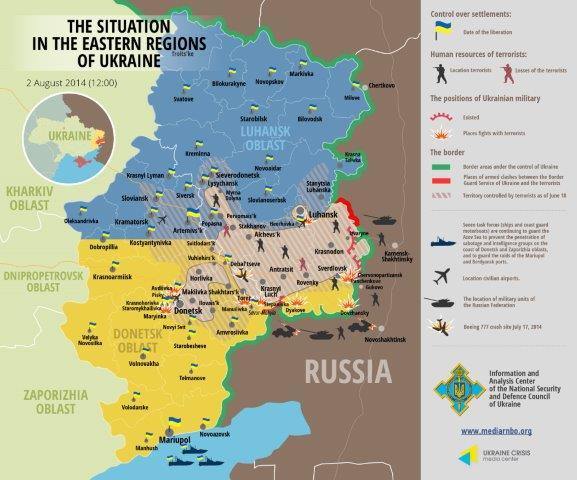
As reported by Reuters, “Ukrainian government forces tightened the noose around the main stronghold of pro-Russian rebels in east Ukraine on Saturday August 2, 2014 and, with diplomacy stalled, Moscow and the West stepped up their war of words. The seizure of Krasnohorivka and Staromykhailivka, towns just outside Donetsk, brought the army to the edge of one of the last cities still in rebel hands following its advances in the past month. The other is Luhansk, near the border with Russia.”
On August 3, 2014 the terrorist IAF in Donetsk were almost encircled by the Ukrainian army. As reported by UNIAN with reference to the RNBO, the territory controlled by terrorists was reduced by 75%.

On August 4, 2014, the Ukrainian army liberated Yasynuvata, Donetsk Oblast. Yasynuvata is an important railroad point. As reported by BurkoNews.info this town is an important strategic objective that gives control over the roads to Donetsk from the North. Liberating Yasynuvate allowed Ukrainian forces to encircle Donetsk from the north and to cut off of the important channels of delivery of arms and military equipment to the terrorist IAF. The operation regarding the identification and the elimination of the rest of the terrorists IAFs has been launched in the city. Furthermore, Ukrainian servicemen unblocked the roads connecting the Dmytrivka and Diakove settlements. The volunteer battalions “Shakhtarsk” and “Azov” from the West pushed terrorist IAFs out of the Mariinka area in close vicinity with Donetsk city.
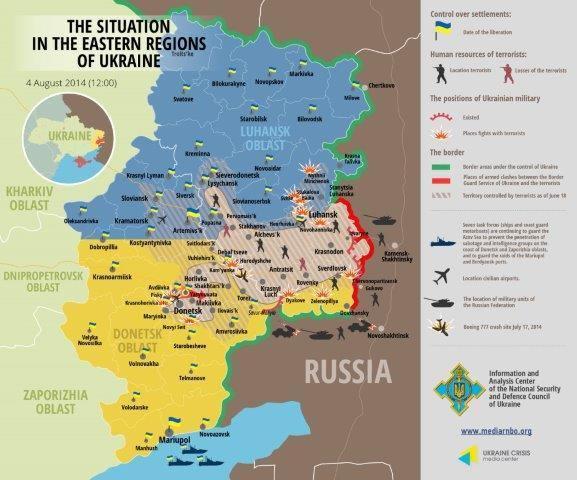
Ukraine is learning not only how to fight an undeclared hybrid was against Russia; some ‘humanitarian’ aspects of this hybrid war were not left without attention either.
Many questions exist why the worldview and history (more precisely, the distortion of historical events and wrong interpretations of history) are so important for Putin’s Russia. The issue is that Russian extremists consider worldview and history as warfare tools in this hybrid war as well.
Russian extremist theories of world dominance see the warfare from a perspective which could be unusual for Western audiences. Russians understand warfare far wider then one can expect. They see 6 major priorities in warfare (the more potent is to create an irreversible result and the more sustainable, but slower in time are at the top, the less potent tp create sustainable result but faster are at the bottom). This concept is known as the Social Security Concept of the all-Russian political party “Truth and Unity Course”. Hearings of this concept in the Russian Paliament (State Duma) took place on November 28, 1995 (text of the hearings can be found here). It was at the time when the West considered that democratic developments in Russia were irreversible and that Russia would be an allied country with Western democratic values.

1. Methodological priority: World view and methodology – changing worldview and methodology as warfare method (how a person sees the world) is the most potent from the sustainability point of view. That is why the Russian Orthodox Church and the creation of the “Russian World” as all-encompassing worldview is of utmost priority for Russia in order to achieve long-term goals.
2. Chronological priority, the warfare of history – to distort history and chronology in order to justify claims on new territories both for external and internal users as well as to brainwash external and internal victims with propaganda for them to consider Russian claims as legitimate.
3. Priority based on facts and their interpretations: ideology, technology, methodology. The examples: Russian Doctrine, ideology of Russia as Third Rome, Alexandr Dugin’s ideology and his Eurasianism, Panslavism based on distorted historical interpretations (see above – 2nd chronololgical priority).
4. Economics priority: eсonomics and finance warfare (example – trade wars against Ukraine, use of the unjustified gas price as war instrument against Europe and Ukraine, Russian banking and finance system as warfare tool against Ukraine, currency speculations and throw-in of counterfeit local currency in order to destabilize Ukrainian currency and the Ukrainian monetary system, strategy to buy sovereign debt of victim country and then to request immediate debt re-payment etc.)
5. Ecological priority, “Genetics” warfare (alcohol, tobacco, environmental pollution e.t.c.) – to promote in the victim country a tolerance to abuse of alcohol, narcotics, to support environmental pollution, deliberately destroying the infrastructure and industrial capacities of victim county e.t.c. With this priority Russia is making efforts to destroy the infrastructure of Donetsk and Luhansk Oblast. The terrorists mined the Stirol chemical plant, threatening to cause an environmental catastrophe in the Donetsk Oblast.
6. Military priority: conventional warfare. Military warfare was used by Russia in a new form of an undeclared hybrid war with a wide application of newly created Special Operation Forces (SSO) in combination with use of local residents brainwashed by the ‘higher’ priorities of warfare described above.
The Special Operations Forces of the Russian Federation (SOF or SSO
in Russian) is a highly mobile group of trained and equipped forces of the Russian Ministry of Defense designed for specific tasks abroad and domestically. The Russian SOF is new unit in Russian army.
Valery Gerasimov, Chief of General Staff of the Armed Forces of Russia announced the creation of the Special Operation Forces on March 6, 2013. Speaking to foreign military attachés, he said, "We created the command of the forces which is engaged in routine work and conducts planned activities in the framework of the preparation of the Armed Forces".
Special operations forces are troops designated to achieve Russian political and economic goals in any geographical part of the world which is of interest to the Russian Federation. These troops are fighting in peacetime.
The Russian SOF, besides such acute operations, usually solve the most incredible and ‘delicate’ tasks. They come into action when diplomatic methods are no longer useful. They can distract the energy and attention of ‘certain’ countries from external problems, creating problems inside these countries, shake the political system of these countries, destabilizing the political situation within these countries, including the use of third parties and local residents of the victim country. Special operations forces are designed to create, train and supervise foreign guerrilla movements, eliminate unwanted leaders on foreign territory without any UN sanctions.
The first drill of the Russian Special Operation Forces (SOF) units was conducted on a mountain range in the Kabardino-Balkaria region in April 2013. During the drill, an airlift of SOF units by military transport and army aviation occured, landing groups and cargo to the special assignment area. As described by the Russian military journalist Aleksandr Sladkov (video + article in Russian) during this drill, the SOF demonstrated variants of their possible actions in nieghboring countries. Drills were an imitation of the redeployment of SOF units to the territory of a neighboring country. As Censor.net reported, the same Russian military journalist, Aleksandr Sladkov, was seen fighting with terrorists against the Ukrainian army (perhaps learning more about Russian SOF fighting in Ukraine)
Photos: First drill of the Russian Special Operation Forces (from military diary of Igor Korotchenko)
The first baptism of these forces tool place in Ukraine during the seziure of the Crimean Parliament on February 27, 2014 (video with the Crimean report of unit No. 090900, February 22-28, 2014) and then in the Donetsk and Luhansk Oblasts.
Ukraine was the first country which faced this type of total hybrid war and Ukraine made conclusions how to fight a well-prepared enemy using new warfare tools.
Has Ukraine learned lessons from this? Yes, certainly. One announcement on June 18, 2014 by the then Minister of Defense, in the Ukrainian mass media went unnoticed by the wider public. "The President of Ukraine, Supreme Commander, and the National Security Council approved a new structure, which in the future will be ready for combat and will be on duty defending our country," Mykhailo Koval told reporters. He added that this structure is a unit of the Ukrainian Special Operations Forces. Special Operation Forces will take part in the settlement of the situation in the east of the country.
As reported by Interfax, the creation of the Ukrainian Special Operation Forces was discussed at a meeting between Hryhoriy Pedchenko, Chief of Staff of the Armed Forces of Ukraine with James Stavridis, NATO's Supreme Commander of Allied NATO forces in Europe on July 19, 2014.
"To enhance the capacity of the Armed Forces of Ukraine in anti-terrorist, information and psychological operations, to ensure security, national maritime navigation, protection of the life and health of citizens and Ukrainian property outside of Ukraine, Ukraine plans to create a separate branch of its service - Special Operations Forces," the Ministry of Defense statement said.
Not attracting the attention of wide public and Russia to this plans supposedly was made on purpose to prepare a huge surprise to the terrorist IAF and to Russia.
Petro Poroshenko, President of Ukraine, announced implementation of a radically new tactic of warfare during his visit to the National Guard in the village of Petrivtsi, Kyiv Oblast. According to the new tactics, servicemen taking part in the anti-terrorist operations in the east were to avoid significant casualties, Ukrinform reported on July 27, 2014.
Ukraine has dramatically changed its tactics of military operations. During the liberation of the heavily armed Dzerzhynsk Ukrainian army sabotage units were used. The army avoided enormous casualties both among the civilian population in the first place, and among our troops," he said .
Valeriy Heletey, the Ukrainian Defense Minister, confirmed on "Shuster Live” that the Ukrainian army already has a Special Operations Force. They are able to perform the most complex tasks, in particular, they liberated the town of Dzerzhynsk without suffering any casualties, while destroying many terrorists.
"When I was appointed as minister of defense, I had a long conversation with the President of Ukraine, surrounded by experts who know battlefields, and one of the first tasks given to me was the creation of a special operations force in the Ukrainian army. And, I can tell you that the legal process of their formation is on-going, but in fact they are fighting today," he said.
According to the minister of defense, special operations forces were involved in the liberation of Dzerzhynsk from terrorists. "It was a difficult area before entering Horlivka. Nevertheless the town was taken under control by the Special Operations Forces. A large number of terrorists together with their military equipment were destroyed," Heletey said. Most importantly - no Ukrainian Special Operation Forces servicemen were killed. "Yes, there were some injuries, three concussions, but everybody is alive and well. This is what I'm talking about - that the Ukrainian army learned to fight," he said.
Photo fact from News of Ukraine | STN: Photos from the successful operation of the Ukrainian SOF units during the liberation of Dzerzhynsk on July 22, 2014:
Another successful example of a Ukrainian SOF operation announced by the President of Ukraine, Petro Poroshenko, was the release of 17 hostages in Horlivka on July 29, 2014. "Today we released 17 hostages, among them Ukrainian soldiers and 1 civilian foreigner. They were kept in captivity in Horlivka" - said Poroshenko on his FB page. According to this information, the President will make every effort to release all hostages. "I can say one thing - Ukraine is proud of the courage which our people exemplified while in captivity. And we will do everything in order to release everybody who still held in captivity by terrorists", said Poroshenko. Meanwhile, work on the release of other hostages continues. Poroshenko continues to personally control the issue of the hostages.
This is excellent reply to Russian propaganda used to demoralize Ukrainian troops. Russian propaganda exploited the message that the Ukrainian President and the Ministry of Defense forgotten about the captive servicemen, had left them to their own devices with the terrorists and did not care about their destiny.
Photos from the Photogallery of Petro Poroshenko: reception of released hostages by Petro Poroshenko and their meeting with relatives.
We are now witnesses of a new Ukrainian Army born from the ashes. Russian servicemen and terrorists waging war in Eastern Ukraine started to realize, according to radio intercepts, that ‘Ukrainians fight better, it’s a full-fledged army’.
It is not surprising that the potential of Ukraine and its army is recognized by Kremlin advisors. They realize more and more that a stronger and more successful Ukraine will be a greater threat to the Putin regime in Russia. Putin advisor Sergei Glazyev even suggested hitting the Ukrainian army to prevent it getting stronger. He said it during a roundtable in Moscow.
Engulfed by mad dreams, he alleged that the Ukrainian authorities have set a course of militarization and mobilization of the population against Russia. “Look at the dynamics - in December 2013, the Nazis had two thousand people in Kyiv. In February 2014, 20 thousand; in May 2014, 50 thousand, together with servicemen. By midsummer there will be 100 thousand; in September 2014, 200 thousand, and by the end of the year they will have 500 thousand armed people,” said Sergey Glazyev, adding that Ukraine is “unmothballing” its military equipment.
“We will get a powerful military machine directed against us, loaded with Nazis and those ideologically charged against Russia … The ultimate goal of all these actions is war against Russia. We cannot, by losing the Donbas, keep the peace, as the next target which is declared, is Crimea,” he said.
Russian will try to do its utmost to crush Ukraine using all possible and impossible means. That is why it is essential that the US, Canadian and European leaders’ implement new sanctions against Russia in the banking, energy, arms and shipping sectors. But this is not enough to stop a mad and unpredictable Russia.
Pavlo Klimkin, the Ukrainian Foreign Minister, asked international observers not to overestimate the significance of the sanctions adopted against Russia.
European Union sanctions against Russia are unique, but should not be treated as guarantors of pressure on the Russian government. "You see, we do not need to overestimate the sanctions. Sanctions are not yet a victory, it is like a second front. These restrictions - are not a panacea, but if you combine them with other drugs, they can certainly work more efficiently," - said Pavlo Klimkin in the TV program "Shuster live" on August 1, 2014.
Andrei Illarionov, former adviser to the Russian President and ex-director of the Institute of Economic Analysis, said on the same TV program that sanctions imposed by the EU and by its ally, the United States, are extremely narrow in their field and selection. They simply can not influence and change the decision-making process in Moscow.
"The sanctions of the United States and the EU are not as effective as they claim. They have an extremely narrow focus, are very selective. They refer only to a few individuals and to several companies. For this reason, such restrictions are not able influence a decision by Moscow to any large extent ", - said former Putin adviser.
The expert emphasized that the general orientation of sanctions that have been applied to such countries as Iraq, Iran, North Korea, often do not have a significant and expected effect.
"Russia, if it is compared with these countries, is a tremendous power. The Russian economy is more diversified, its connection is much more diverse. To achieve a result, it is necessary to apply a much broader action, including large-scale sanctions", said Andrei Illarionov.
No one wants a repetition of WWII in the 21st century. The situation is similar to the so-called Phoney War. The Phoney War was a phase early in World War II that was marked by a lack of major military operations by Western Allies (the United Kingdom and France) against the German Reich. The phase covered the months following Britain's and France's declaration of war on Germany in September 1939 and preceding the Battle of France in May 1940 (shortly after the invasion of Poland on September 1, 1939). The war was declared by each side, but no Western power had committed to launching a significant land offensive, notwithstanding the terms of the Anglo-Polish and Franco-Polish military alliances, which obliged the United Kingdom and France to assist Poland. On top of that, when Stalin, who was the instigator of WWII as Hitler’s ally that time, invaded Poland on September 17, 1939 taking advantage of Molotov–Ribbentrop Pact
, neither the UK nor France declared war on the USSR.
Europe woke up on May 10, 1940, eight months after Britain and France had declared war on Germany, when German troops marched into Belgium, the Netherlands and Luxembourg, marking the end of the Phoney War. On June 14, 1940 German troops entered Paris. The Second Armistice at Compiègne was signed at 18:50 on June 22, 1940 near Compiègne, France, between Nazi Germany and the Third French Republic. Following the decisive German victory in the Battle of France (May 10 - June 21, 1940), it established a German occupation zone in Northern and Western France that encompassed all English Channel and Atlantic Ocean ports and left the remainder "free" to be governed by the French. Adolf Hitler deliberately chose the Compiègne Forest as the site to sign the armistice due to its symbolic role as the site of the 1918 Armistice with Germany that signaled the end ofWorld War I with Germany's surrender. A puppet govenment with Marshall Petain as head was formed. On June 23, 1940 Hitler toured Paris in triumph over the defeated city. On July 1, 1940, the French puppet government, under the new leadership of Marshall Petain, moved to Vichy. On July 10, 1940 the German Luftwaffe launched Battle of Britain. That was the dear price paid by Europe for its unwillingness to withstand Hitler’s aggression when Hitler crossed the line.
In order not to repeat these tragic lessons we need to understand that Putin must be stopped in Ukraine. Currently the decisive factor to stop Putin in Ukraine are the Ukrainians and the Ukrainian army. Ukraine needs military help. Not personnel, but weapons, heavy military equipment, military technologies, military advice in the build-up Ukrainian army in different areas, and including US and NATO experience with US Special Operation Forces (SOF) and NATO state SOF operations.
Russia is desperate and unpredictable now since the Ukrainian armed forces continue successfully to defeat the terrorist illegal armed formations. As an act of desperation Russia has been continuously sending Russian military units to help the terrorists. As reported by The Daily Beast “Russia’s Military Is already in Eastern Ukraine. Russia is moving troops, armor, and advanced antiaircraft missiles toward the border with Ukraine. In the last 48 hours on August 2 - 3, 2014, dozens of videos have been uploaded to social-media sites that show Russian armor very close to the border, many of them confirmed to be within mere kilometers of Ukraine. In the last 24 hours, there are reports of cross-border shelling in new locations and 17 new Grad rocket batteries digging in on the Russian side of the border, but within range of the Ukrainian military’s front lines”. According to information provided by Mykhailo Koval, first Deputy Secretary of the RNBO, presented during the program, “Freedom of Speech" on ICTV on August 4, 2014 Russia created strike groups near its border with Ukraine. The total number of Russian battle troops on the territory adjacent to Ukraine is up to 33 thousand personnel and 160 tanks. "Particularly powerful groups are deployed in Crimea (23 000 Russian servicemen). Equally powerful groups deployed from Chernihiv in the direction of Taganrog. Military command and control personnel have been already deployed there. All these measures which are currently under way in the areas adjacent to Eastern Ukraine are designed to clearly demonstrate the readiness of the armed forces of the Russian Federation to conduct active military actions"- said Mykhailo Koval.
As reported by ITAR-TASS on Monday, August 4, 2014, Russia started five-day Air Force combat drills, which involve a total of over 100 fighter jets, bombers and helicopters in the country’s central and western military districts, a spokesman for the Russian Air Force said on Monday. “In total, the maneuvers will involve 100 planes and helicopters such as the Su-27 Flanker fighter jets, MiG-31 Foxhound fighter jets, multipurpose Su-34 Fullback fighter-bomber, Su-24 Fencer bombers as well as Mi-8, Mi-24 and Mi-28N combat helicopters,” Igor Klimov, spokesman for the Russian Air Force said. The large-scale exercises would be conducted jointly with the Russian air-defense forces, he added. On the same day the Russian Foreign Minister, Sergei Lavrov, officially appealed to the Organization for Security and Cooperation in Europe, the Council of Europe, the International Committee of the Red Cross and the UN "to organize something like an international humanitarian mission" to get aid to the areas in and around Luhansk and Donetsk.
The field drills of army reconnaissance formations started at seven firing ranges in Southern Federal District on Tuesday, August 5, 2014. More than 1.3 thousand servicemen and over 300 units of special military hardware are participating in field drills at firing ranges in Volgograd and Astrakhan regions, Stavropol territory, Russian North Caucasian republics of Adygeya, North Ossetia, Karachay-Cherkessia and Armenia, a country in South Caucasus, the press service of the Southern Military District ITAR-TASS reported. These drills are designed to demonstrate force and put psychological pressure on Europe and Ukraine. Shortly before a real invasion Russian mass media do not usually demonstrate to the world the deployment and combat readiness of Russian troops.
Following such developments substantial military aid from US, EU and NATO is needed. As reported by the Kyiv Post July 21, 2014, Ukrainian President Petro Poroshenko has said that Kyiv may ask for a special status of a non-NATO ally from the US Congress, if everything else fails. Until now, the US, NATO and EU have refused to supply Ukraine with modern weapons and military equipment and technologies. "It's a cowardly act on our [US] part not to give the Ukrainians any defensive weapons. The fact that we did not give them any defensive weapons, which they were begging for, is shameful," US Senator John McCain said on Friday, August 1, 2014 during an appearance on the Phoenix radio station KFYI . McCain said that he believes the Obama administration did not want to provoke Putin. The Ukrainians should get the weapons they need and sanctions of "the stiffest kind" should be imposed on Putin. Prince William in his speech about the legacy of the First World War on August 4, 2014 suggested that conflict in Ukraine is not just a localized war but a threat to the whole of Europe.
The United States of America are just considering the possibility of granting Ukraine the status of an ally without membership in the North Atlantic Treaty Organization (NATO). US Congressmen introduced a bill in the US House of Representatives recognizing Ukraine as main non-NATO ally, as well as providing the country with direct military assistance, as reported by the press service of Republican Jim Gerlach on July 24, 2014. It is very important that this bill be passed as soon as possible. Major non-NATO ally status would entitle Ukraine to broad financial aid from US to buy military equipment and weapons. It confers a variety of military and financial advantages that otherwise are not obtainable by non-NATO countries. EU and NATO states should follow the US initiative and pass similar legislation to provide military equipment and weapons to Ukraine. Ukraine can become the stronghold of free world in Europe. It can happen once the most modern, trained, well-equipped army imbued with a western perspective and values is created with the help of the US, Canada, the EU and NATO member states.
Written by Dr. Vitalii Usenko, MD, MBA, expert of the Center of Military-Political Studies in the sphere of psychology of communications, and Dmytro Usenko, student at Rotman School of Management, University of Toronto
in co-operation with Edmond Huet, Euromaidan Press armament and military questions specialist, consultant to French TV and radio
Edited by Myron Spolsky
Annexes
1. National Security and Defense Council of Ukraine (NSDC) Information Analysis Center.
The situation in the Eastern Regions of Ukraine (July 27 – August 4, 2014).
2. BurkoNews.info. The situation in the Eastern Regions of Ukraine (July 27 – August 4, 2014)
BurkoNews.info is a volunteer initiative to inform the general foreign audiences about developments in Ukraine. The project team consists of journalists, political scientists, military experts, public figures and translators.








